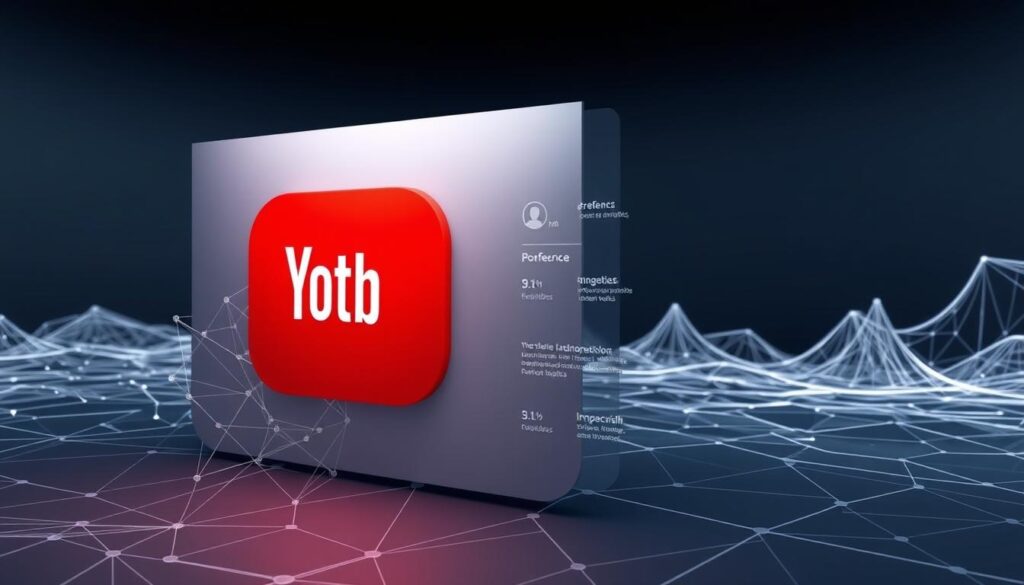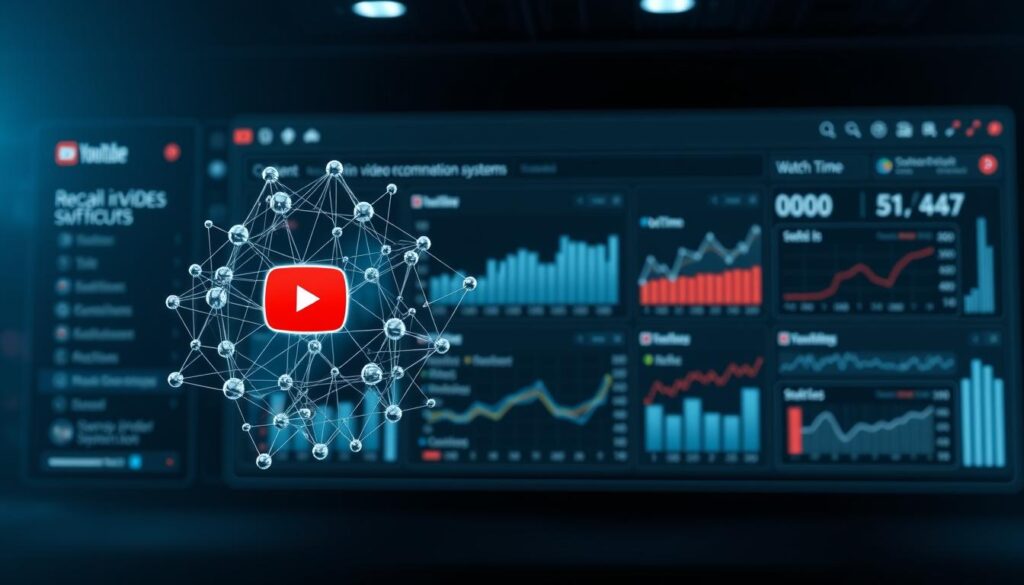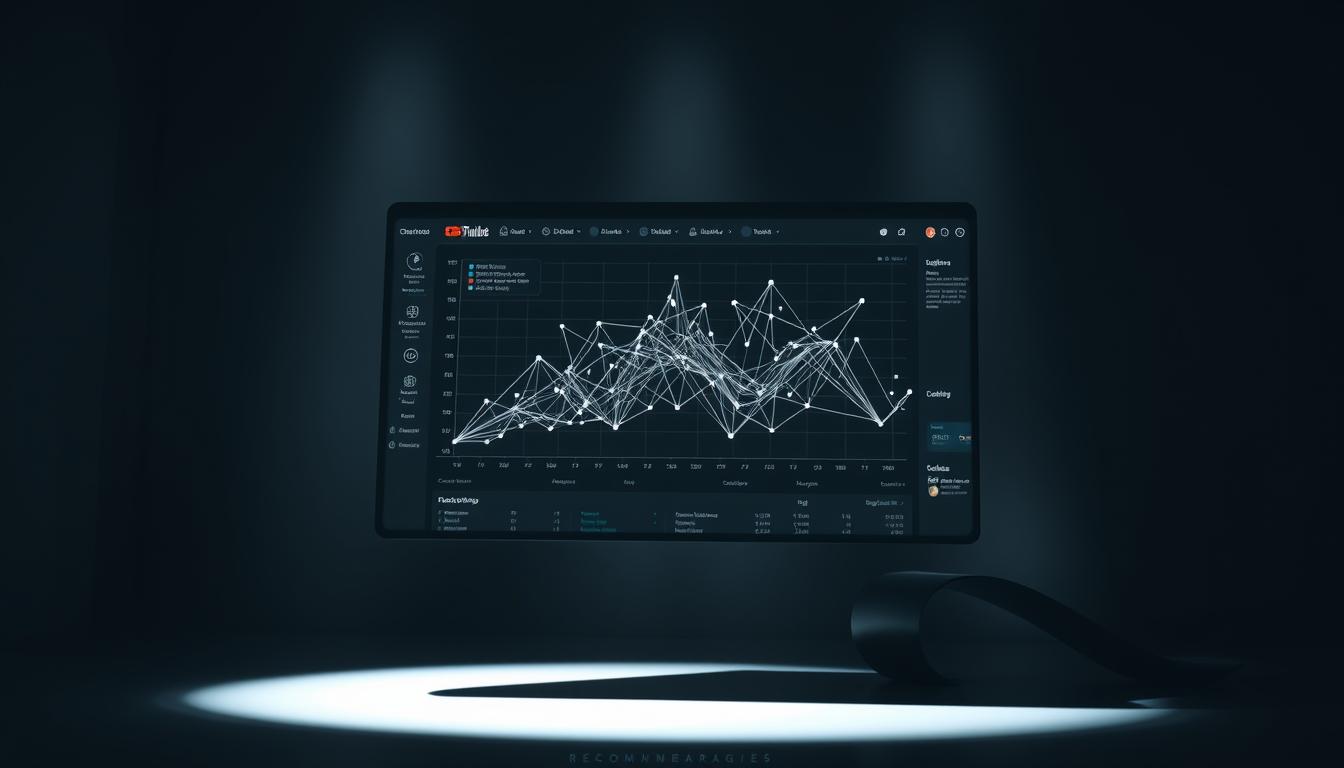Have you ever wondered how YouTube always seems to know exactly what videos you want to watch next? It’s like having a personal video curator at your fingertips.
YouTube’s recommendation algorithm is a complex system that uses a combination of factors to suggest videos you’ll love. From your watch history to the content’s engagement metrics, it’s a sophisticated math-based system that drives the platform’s success.
Understanding how this system works can give you valuable insights into the world of online video content creation.
Key Takeaways
- YouTube’s recommendation algorithm is a complex system that uses multiple factors to suggest videos.
- The algorithm takes into account your watch history, likes, and dislikes.
- Content creators can optimize their videos to improve their visibility in recommendations.
- The system is constantly evolving to improve user experience.
- Understanding the algorithm can help you create more engaging content.
The Evolution of YouTube’s Recommendation System
From its humble beginnings to the sophisticated systems in use today, YouTube’s recommendation technology has come a long way. The platform’s ability to suggest relevant content to users is the result of continuous innovation and significant advancements in algorithmic development.
From Simple Beginnings to Complex Algorithms
YouTube’s recommendation system started with simple algorithms that relied on basic user interactions, such as watch history and ratings. Over time, these algorithms evolved to incorporate more complex data points and machine learning techniques.
Key Milestones in YouTube’s Recommendation Technology
Several key milestones mark the evolution of YouTube’s recommendation system. Two significant developments were the implementation of neural networks in 2012 and the deep learning revolution in 2016.
The 2012 Neural Network Implementation
The introduction of neural networks in 2012 marked a significant shift in YouTube’s recommendation capabilities. Neural networks allowed the algorithm to learn more complex patterns in user behavior and content characteristics.
The 2016 Deep Learning Revolution
The 2016 deep learning revolution further enhanced YouTube’s recommendation system. Deep learning techniques enabled the algorithm to analyze vast amounts of data, including video content, user engagement, and contextual information, to provide more personalized recommendations.
The impact of these advancements can be seen in the improved accuracy and relevance of YouTube’s recommendations. The table below summarizes the key developments in YouTube’s recommendation technology.
| Year | Development | Impact |
|---|---|---|
| 2012 | Neural Network Implementation | Improved pattern recognition in user behavior |
| 2016 | Deep Learning Revolution | Enhanced personalization through complex data analysis |
Why Recommendations Matter: The Business Perspective
YouTube’s recommendation system is the backbone of its business model, driving engagement and revenue. By suggesting relevant content, YouTube keeps users engaged, increasing watch time and, consequently, its ad revenue.
Engagement Metrics and Revenue Generation
The primary metric for YouTube’s success is watch time. Recommendations drive 70% of watch time, making them crucial for revenue generation through ads. This focus on engagement metrics underscores the importance of understanding YouTube’s algorithm.
How Recommendations Drive 70% of Watch Time
By analyzing user behavior and preferences, YouTube’s algorithm provides personalized content suggestions. This personalization enhances user experience, encouraging longer viewing sessions.
Competition in the Attention Economy
YouTube operates in a highly competitive attention economy. Effective recommendations are key to capturing and retaining user attention. As noted by a YouTube executive,
“The algorithm is designed to surface content that users will engage with, based on their past behavior.”
This highlights the complexity and importance ofunderstanding YouTube suggestions.
The Math Behind YouTube Recommendations – Do You Know How It Works?
The YouTube recommendation engine is a marvel of modern mathematics, combining various models to deliver a unique viewing experience for each user. At its core, the algorithm relies on complex mathematical calculations to understand user preferences and suggest relevant content.
Mathematical Models Powering the Algorithm
YouTube’s algorithm utilizes a range of mathematical models to analyze user behavior and preferences. Two key techniques employed are:
Matrix Factorization Techniques
Matrix factorization is a method used to reduce the dimensionality of large user-item interaction matrices. By breaking down these matrices into lower-dimensional representations, YouTube can more efficiently process and analyze user data to provide personalized recommendations.
Probabilistic Models and Bayesian Methods
Probabilistic models and Bayesian methods are used to model the uncertainty in user behavior and preferences. These models allow YouTube to update its understanding of users based on new data, ensuring that recommendations remain relevant over time.

From Raw Data to Personalized Suggestions
The journey from raw data to personalized suggestions involves several mathematical transformations. YouTube’s algorithm processes vast amounts of data, applying various mathematical models to identify patterns and preferences.
The Mathematical Journey of a Recommendation
When a user interacts with YouTube, their actions are recorded and analyzed using sophisticated mathematical techniques. This analysis involves calculating probabilities, applying matrix operations, and using machine learning models to predict the most relevant content for the user.
By understanding the mathematical underpinnings of YouTube’s recommendation engine, we can appreciate the complexity and sophistication of the algorithm that powers our viewing experiences. Decoding YouTube suggestions reveals a world of advanced mathematical modeling and data analysis that works tirelessly to keep us engaged.
Machine Learning Fundamentals in YouTube’s Algorithm
At the heart of YouTube’s recommendation engine lies a sophisticated machine learning framework that enables the platform to suggest videos tailored to individual user preferences. This complex system is designed to analyze vast amounts of data, including user behavior, video content, and engagement metrics, to provide a highly personalized viewing experience.
Supervised vs. Unsupervised Learning Approaches
YouTube’s algorithm employs both supervised and unsupervised learning techniques to achieve its recommendation goals. Supervised learning involves training models on labeled data, where the algorithm learns to predict outcomes based on known inputs. In contrast, unsupervised learning deals with unlabeled data, identifying patterns and relationships without predefined outcomes.
The combination of these approaches allows YouTube to leverage the strengths of both methods. For instance, supervised learning can be used to predict user engagement based on historical data, while unsupervised learning can help identify new trends and patterns in user behavior.
Neural Networks and Deep Learning Applications
Neural networks and deep learning play a crucial role in YouTube’s recommendation algorithm, enabling the platform to analyze complex data sets and make accurate predictions. Deep learning models are particularly effective in handling large-scale video and user data.
Convolutional Neural Networks for Video Content
Convolutional Neural Networks (CNNs) are used to analyze video content, extracting features such as visual and audio patterns. This information helps the algorithm understand the context and relevance of videos, improving recommendation accuracy.
Recurrent Neural Networks for User Behavior
Recurrent Neural Networks (RNNs) are employed to model user behavior over time, capturing sequential patterns in watch history and search queries. This enables the algorithm to predict future user interactions and tailor recommendations accordingly.

| Machine Learning Technique | Application in YouTube’s Algorithm |
|---|---|
| Supervised Learning | Predicting user engagement based on historical data |
| Unsupervised Learning | Identifying new trends and patterns in user behavior |
| Convolutional Neural Networks (CNNs) | Analyzing video content for visual and audio patterns |
| Recurrent Neural Networks (RNNs) | Modeling user behavior over time to predict future interactions |
By integrating these advanced machine learning techniques, YouTube’s algorithm can provide a highly personalized and engaging experience for its users, showcasing the power of the math behind YouTube recommendations.
The Two-Stage Recommendation Process
Understanding how YouTube recommends videos requires delving into its two-stage recommendation process. This process is crucial for providing users with a personalized viewing experience.
Candidate Generation: Creating the Initial Pool
Candidate generation is the first stage of YouTube’s recommendation process. It involves creating a large pool of videos that could potentially interest a user.
How YouTube Narrows Billions of Videos to Hundreds
YouTube uses various signals to narrow down billions of videos to a few hundred potential candidates. This stage is critical for efficiency, as it reduces the number of videos to be ranked later.
| Signal Type | Description | Impact on Candidate Generation |
|---|---|---|
| User History | Videos watched, liked, or disliked by the user | High |
| Video Metadata | Title, tags, description, and thumbnail | Medium |
| User Engagement | Likes, comments, shares on the platform | High |
Ranking: Sorting and Prioritizing Recommendations
After generating a pool of candidate videos, YouTube’s algorithm ranks them based on a predicted user engagement score.
The Mathematical Scoring Function
The scoring function is a complex mathematical formula that predicts how likely a user is to engage with a video. It considers multiple factors, including watch time, click-through rate, and user feedback.

By understanding the two-stage process of candidate generation and ranking, we can appreciate the complexity and sophistication of YouTube’s recommendation algorithm.
Key Metrics That Drive Recommendations
YouTube’s recommendation system is driven by a complex algorithm that weighs various key metrics to determine the videos that users see on their homepage and in their subscription feed. Understanding these metrics is crucial for content creators and marketers who want to maximize their video’s visibility.
Watch Time and Engagement Signals
Watch time is a critical metric for YouTube’s algorithm, as it indicates how engaging a video is. The longer users watch a video, the more likely it is to be recommended. Engagement signals, such as likes, comments, and shares, also play a significant role in determining a video’s relevance and quality.
- Likes and dislikes help the algorithm understand user preferences.
- Comments and shares indicate a high level of engagement.
- Watch time is a key indicator of a video’s relevance.
Click-Through Rate and User Satisfaction
Click-through rate (CTR) is another important metric that measures how often users click on a video after seeing its thumbnail and title. A high CTR indicates that the video’s title and thumbnail are appealing and relevant to users. User satisfaction is also crucial, as it encompasses various factors, including watch time, CTR, and user feedback.
Key factors influencing user satisfaction include:
- Relevance of the video content to user interests.
- Quality of the video, including production values and information accuracy.
- User engagement, such as likes, comments, and shares.
Freshness and Relevance Factors
YouTube’s algorithm also considers the freshness and relevance of content. Newly uploaded videos are given a boost in visibility, especially if they are relevant to current trends or events. The algorithm assesses the relevance of a video based on its content, metadata, and user engagement.
The Mathematical Weighting of Different Signals
The algorithm mathematically weighs different signals to determine the recommendations. For instance, watch time might be given more weight than CTR for certain types of content. The exact weighting is complex and varies depending on the context, including the type of video, user preferences, and current trends.

In conclusion, YouTube’s recommendation system is driven by a multifaceted algorithm that considers various key metrics, including watch time, engagement, CTR, and freshness. Understanding these metrics and how they are weighted can help content creators and marketers optimize their content for better visibility.
Your Digital Footprint: How User Data Shapes Recommendations
Your interactions with YouTube contribute to a unique digital footprint that shapes the content you see. This digital footprint is built from various user signals that YouTube’s algorithm interprets to provide personalized recommendations.
Explicit vs. Implicit User Signals
YouTube collects both explicit and implicit signals from its users. Explicit signals include likes, dislikes, and subscriptions, which directly indicate user preferences. Implicit signals, on the other hand, are derived from user behavior such as watch history and search patterns.
The Role of Watch History and Search Patterns
Watch history and search patterns play a crucial role in shaping recommendations. YouTube analyzes the videos you watch and the keywords you search for to understand your viewing preferences. This information helps the algorithm suggest videos that are likely to interest you.
Demographic and Geographic Influences
Demographic and geographic data also influence YouTube’s recommendations. Factors such as age, gender, and location can affect the types of videos suggested to you. For instance, users in different regions may see different trending videos based on local popularity.
How YouTube Balances Personal and Population Data
YouTube’s algorithm balances personal data, such as your watch history, with population data, which reflects broader trends and popular content. This balance ensures that recommendations are both personalized and diverse.
To illustrate how different factors influence recommendations, consider the following table:
| Factor | Influence on Recommendations | Example |
|---|---|---|
| Watch History | Videos similar to those you’ve watched | If you often watch cooking videos, YouTube may suggest more recipes. |
| Search Patterns | Content related to your search queries | Searching for “fitness routines” may lead to recommendations for workout videos. |
| Demographic Data | Content popular among your demographic | Younger viewers might see more trending music videos. |

Understanding how YouTube uses your data can help you make informed decisions about your viewing habits and privacy settings. By being aware of the factors that influence recommendations, you can better manage your digital footprint on the platform.
Content-Based Filtering vs. Collaborative Filtering
To decode YouTube suggestions, it’s essential to explore the dual strategy of content-based and collaborative filtering that powers its recommendation engine. YouTube’s algorithm doesn’t rely solely on one method; instead, it combines the strengths of both approaches to provide users with a personalized viewing experience.
Understanding Content-Based Recommendation Systems
Content-based filtering focuses on the attributes of the videos themselves. By analyzing the metadata and content of videos a user has watched, YouTube can suggest similar videos that might interest them.
Vector Representations of Video Content
Videos are represented as vectors in a multidimensional space, where each dimension corresponds to a specific attribute, such as genre, director, or keywords. This vector representation allows for efficient comparison and recommendation of videos based on their inherent characteristics.
The Power of Collaborative Filtering
Collaborative filtering, on the other hand, leverages the behavior of the community to make recommendations. It assumes that users with similar viewing habits will likely be interested in the same content.
User-Item Matrix Calculations
Key aspects of collaborative filtering include:
- Creating a user-item matrix that captures user interactions with videos
- Calculating similarity between users or items based on their interaction patterns
- Generating recommendations for a user based on the preferences of similar users
How YouTube Combines Both Approaches
YouTube’s recommendation algorithm doesn’t favor one technique over the other; rather, it integrates both content-based filtering and collaborative filtering to achieve a more robust and diverse set of recommendations. This hybrid approach allows YouTube to suggest videos that are not only relevant to a user’s past viewing behavior but also introduce them to new content they might enjoy.
Ethical Considerations and Algorithmic Bias
YouTube’s algorithm, designed to keep users engaged, has sparked debates about ethical considerations and potential biases. As the platform continues to evolve, it’s crucial to address these concerns to ensure a fair and transparent user experience.
The Challenge of the Filter Bubble
The filter bubble effect, where users are exposed to a limited range of content, is a significant ethical concern. This phenomenon can lead to the reinforcement of existing beliefs and the suppression of diverse perspectives. To mitigate this, YouTube must balance personalization with the need to expose users to a wide range of content.
Content Moderation and Recommendation Responsibility
YouTube’s algorithm plays a critical role in content moderation, as it influences what content is recommended to users. Ensuring that the algorithm is fair and unbiased is essential. This involves ongoing monitoring and adjustments to prevent the promotion of harmful or inappropriate content.
Mathematical Approaches to Reducing Harmful Content
Mathematical models can be employed to identify and reduce harmful content. Techniques such as machine learning and natural language processing can help detect and filter out content that violates community guidelines. By leveraging these approaches, YouTube can enhance its moderation capabilities and provide a safer environment for users.
Balancing Personalization with Diversity
One of the key challenges facing YouTube’s algorithm is balancing personalization with the need to promote diverse content. While personalization keeps users engaged, it’s equally important to expose users to new ideas and perspectives. Achieving this balance requires sophisticated algorithmic techniques that can cater to individual preferences while fostering a diverse and inclusive online community.
Taking Control: Influencing Your Recommendations
Taking control of your YouTube recommendations is easier than you think, and it starts with understanding how to interact with the platform. By making a few simple adjustments, you can significantly impact the content that’s recommended to you.
Practical Tips to Customize Your Feed
To start customizing your YouTube feed, you can use the platform’s built-in features. For instance, you can rate videos by liking or disliking them, which helps the algorithm understand your preferences.
Understanding the “Not Interested” Button
The “Not Interested” button is a powerful tool for shaping your recommendations. When you click this button, YouTube’s algorithm takes note and adjusts your future recommendations accordingly.
How User Feedback Affects the Algorithm
User feedback, including ratings and the “Not Interested” button, plays a crucial role in shaping your YouTube recommendations. By providing feedback, you’re helping the algorithm understand what you like and dislike.
| Action | Impact on Recommendations |
|---|---|
| Liking a Video | Increases the likelihood of similar content being recommended |
| Disliking a Video | Decreases the likelihood of similar content being recommended |
| Using “Not Interested” | Removes the video from your recommendations and reduces similar content |
Managing Your Watch and Search History
Managing your watch and search history is another way to influence your YouTube recommendations. You can clear your watch history or pause it to prevent certain videos from affecting your future recommendations.
Conclusion: The Future of YouTube Recommendations
YouTube’s recommendation algorithm has evolved significantly over the years, transforming the way users interact with the platform. Understanding the youtube algorithm explained is crucial in grasping how the platform suggests content to its vast user base.
As we’ve seen, the algorithm relies on a complex interplay of factors, including user behavior, watch history, and engagement metrics. Decoding youtube suggestions reveals a system that is both personalized and dynamic, adapting to the user’s preferences and viewing habits.
Looking ahead, the future of YouTube recommendations is likely to be shaped by advancements in machine learning and AI. As the platform continues to refine its understanding youtube suggestions, we can expect even more accurate and relevant content recommendations.
The implications of these developments are significant, with potential impacts on content creators, advertisers, and users alike. As YouTube continues to evolve, one thing is clear: the math behind YouTube recommendations will remain a critical component of the platform’s success.
